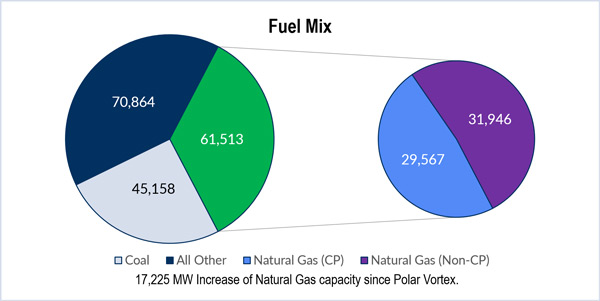VALLEY FORGE, Pa. — PJM is expecting “typical” temperatures and almost 50,000 MW of capacity beyond its projected peak load for the first winter using Capacity Performance, PJM’s Chris Pilong told the Operating Committee last week.
While recent winters were impacted by anomalies such as El Nino, weather this season is likely to be about “average,” he said. PJM’s installed capacity for the winter is 183,665 MW, with 177,525 MW committed through the Reliability Pricing Model. The forecasted peak load is 135,548 MW.
“Average temperatures aren’t going to be what’s driving us as far as peak-load days,” he said. “It’s going to be the outliers.”
Natural gas-fired capacity has increased by 17,225 MW since the polar vortex nearly three years ago to 61,513 MW, he said, about 35% of committed capacity. Of that, about half — 31,946 MW — is committed through CP.
An Operations Assessment Task Force assessment of pipeline-disruption sensitivity found no reliability issues for base and N-1 analyses, Pilong said. “The good news was even under the worst-case scenario, everything was solid,” he said.
By the end of the year, an additional 2,800 MW of generation will have been brought online since this summer, he said. The system also will have the benefit of transmission upgrades on the Baltimore Gas and Electric, Dominion, Commonwealth Edison and American Electric Power systems.
PJM Moves to Cut Operator-Training Grace Period in Half
The grace period for dispatchers at utilities’ market operations centers and small generation plants to complete initial training will be reduced from 12 months to six months in revisions PJM is proposing for Manual 40.
“Our long-range plan is to get that number [for the allowable grace period] to zero,” PJM’s Glenn Boyle said. “What we’re saying is that’s too much exposure risk.”
He said PJM is hoping to have the grace period removed entirely by next year.
Regulation Requirement Changing from ‘Peak’ to ‘Ramp’
PJM is proposing to change the way it sets regulation requirements, replacing the targets for on- and off-peak periods with those for on- and off-ramp intervals to better capture seasonal system conditions.
The revisions, which will be incorporated in Manuals 11 and 12, were recommended by the Regulation Market Issues Senior Task Force.
The lower regulation requirement of 525 effective MW, which currently applies during off-peak hours of midnight to 04:59, would apply during off-ramp hours. The requirement for the on-peak hours of 05:00 to 23:59 would be applied to the on-ramp and increase from 700 to 800 effective MW.
On- and off-ramp periods will vary by season. From Sept. 1 through Nov. 30, for example, the on-ramp period will be hours ending 6:00 through 8:00 and 18:00 through 24:00. For the winter, the morning ramp starts one hour earlier and ends one hour later while the evening ramp begins an hour earlier.
The seasonal periods will be posted on the RTO’s website. PJM’s Eric Hsia said he plans to also announce them at the Operating Committee meetings starting two months prior to the beginning of the affected season.
PJM Won’t Pay for Frequency Response Under FERC NOPR
FERC’s Nov. 17 rulemaking that would require most new generators to have primary frequency response capability left it to individual RTOs to decide if compensation is warranted for the service, and PJM currently believes it’s not, Hsia said.
The rule would apply to both synchronous and nonsynchronous facilities as a condition of interconnection. Nuclear units are exempt.
Hsia said he didn’t agree with the argument that generators should be compensated for lost-opportunity costs, noting that the Notice of Proposed Rulemaking would not require them to preserve “headroom” for the frequency response when offering their output for sale (RM16-6). (See FERC: Renewables Must Provide Frequency Response.)
He acknowledged “ongoing conversation” on the topic, however. Comments on the NOPR are due to FERC on Jan. 24.
Members Question Redundancy of Pseudo-Tie Efforts
Members asked PJM staff why the RTO is seeking to create a pro forma pseudo-tie agreement when the issue of pseudo-ties is already being discussed by the Underperformance Risk Management Senior Task Force.
“The lack of this agreement has resulted in a lack of uniformity,” PJM’s Jacqui Hugee said.
Staff wanted to develop such a document for the task force but couldn’t complete it fast enough to avoid delaying the task force’s progress, she said. The effort to develop a pro forma document is being done in coordination with the task force, she said, and PJM doesn’t plan to make multiple filings on the topic with FERC. (See related story, MISO Stakeholders Narrowly Support New Pseudo-Tie Rules.)
– Rory D. Sweeney




